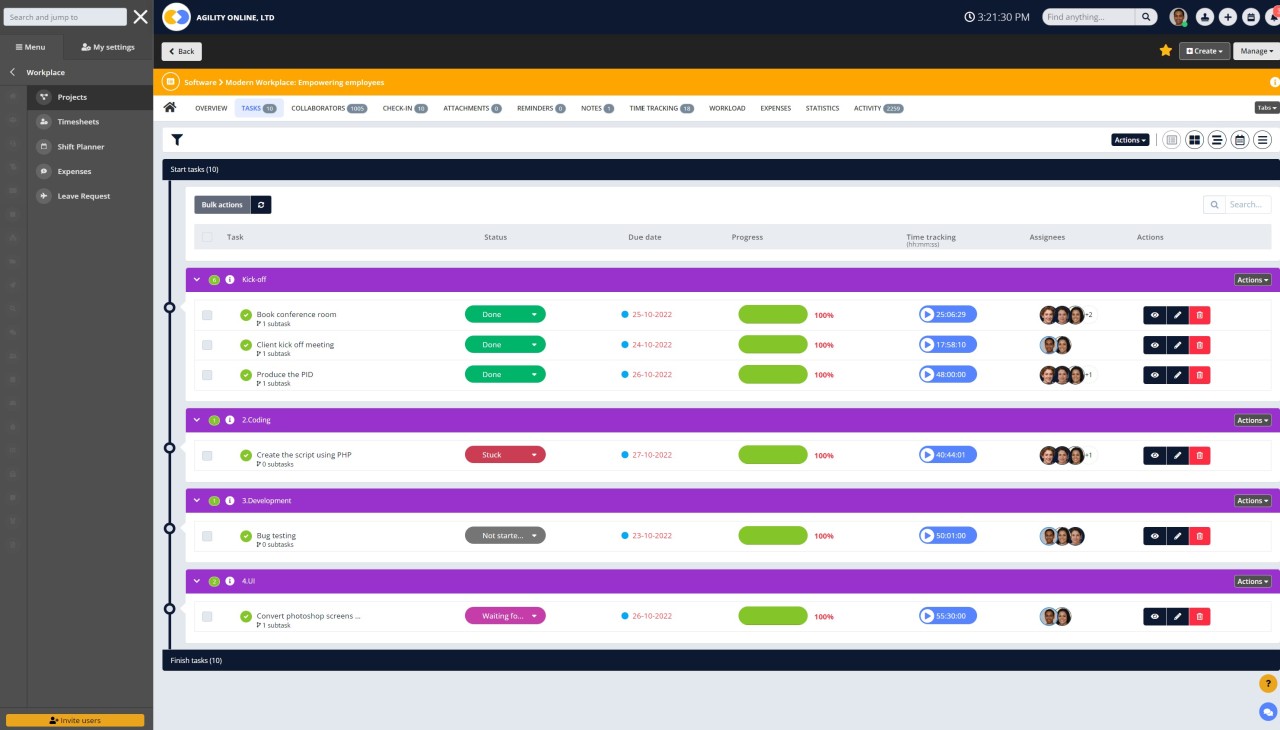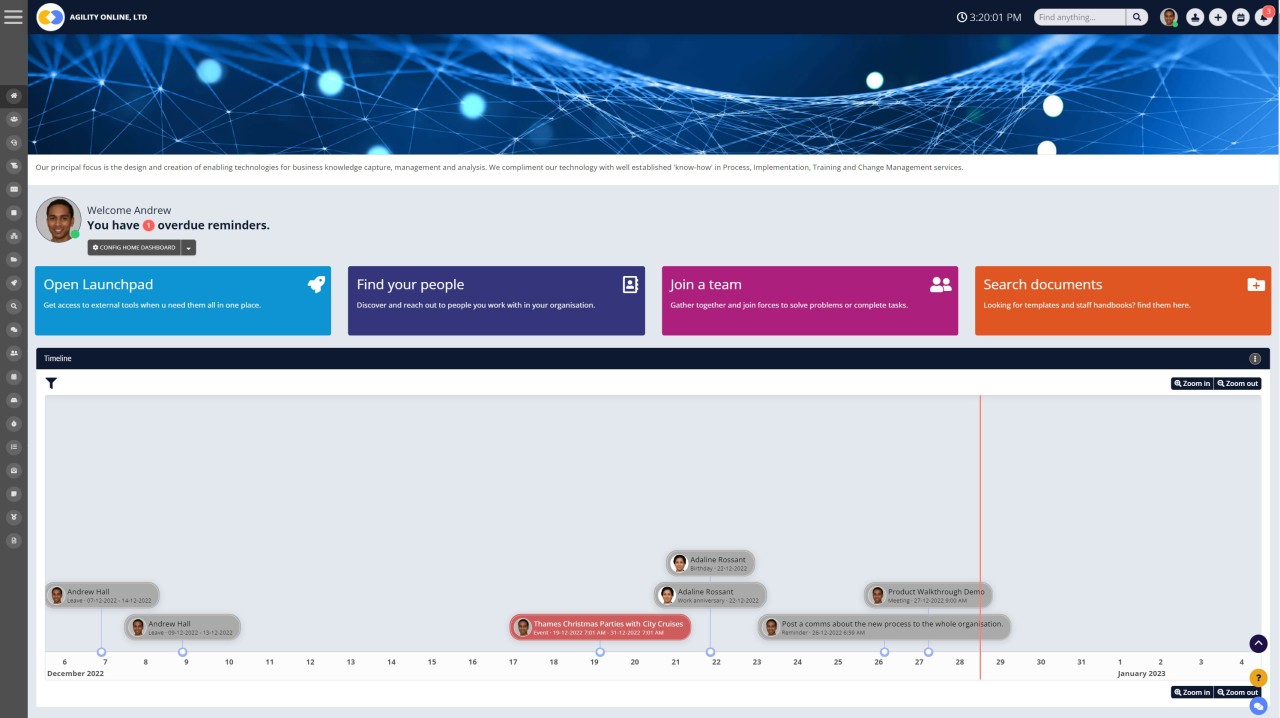Insight Blog
Agility’s perspectives on transforming the employee's experience throughout remote transformation using connected enterprise tools.
14 minutes reading time
(2815 words)
Importance of collaboration in the workplace: Why its Important in 2022?
The Importance of collaboration in the workplace improves the way your team works together and problem solves. This leads to more innovation, efficient processes, increased success, and more.
The benefits of collaboration to businesses and employees are manifold. Collaborative workers and managers may boost workplace output, and firms may see less employee churn. Working effectively with others is essential for long-term professional success, regardless of your endeavor.
This article will discuss the benefits of collaboration and some ways to enhance your team's ability to work together effectively.
The Key elements of collaboration
There are several key elements that contribute to successful collaboration in the workplace. These include:
- Clear goals and objectives: Collaboration is most effective when everyone is working towards a shared goal or objective. It's important to make sure that everyone understands what needs to be achieved and how their contribution fits into the bigger picture.
- Effective communication: Good communication is essential for successful collaboration. This includes clear and open communication channels, as well as a willingness to listen to others and respect their ideas and perspectives.
- Trust and respect: Trust and respect are essential for building a collaborative team culture. This means valuing the input and expertise of others and being open to feedback and constructive criticism.
- Inclusivity: Collaboration is most effective when it includes diverse perspectives and experiences. It's important to ensure that everyone has an equal opportunity to contribute and be heard.
- Collaborative tools and technologies: Technology can make it easier for team members to collaborate, even when they are not in the same location. Tools such as project management software, virtual meeting platforms, and document sharing tools can help facilitate collaboration.
- Flexibility: Collaboration often requires a degree of flexibility and adaptability. This may involve being open to new ideas, changing course when necessary, and finding ways to work effectively with different personalities and working styles.
The benefits of collaboration in the workplace
Collaboration in the workplace can bring a number of benefits to both individual employees and the organization as a whole. Some of the potential benefits of collaboration include:
- Improved problem-solving and decision-making: When multiple people work together to tackle a problem, they can bring different perspectives and expertise to the table, which can lead to more creative and effective solutions.
- Increased efficiency: Collaboration can help streamline processes and reduce the time it takes to complete tasks by allowing employees to divide and conquer.
- Enhanced communication and teamwork: Collaboration helps build strong working relationships and can improve communication between team members. This can lead to a more cohesive and collaborative team culture.
- Enhanced learning and development: Collaboration can provide opportunities for employees to learn from each other and develop new skills through shared experiences and knowledge sharing.
- Improved morale and job satisfaction: When employees feel like they are contributing to a common goal and are valued for their input, they are more likely to be engaged and satisfied with their work.
Overall, collaboration in the workplace can help organizations achieve their goals more effectively and efficiently, while also providing employees with the opportunity to grow and develop.
Why should you prioritize improving collaboration in the workplace?
Coworkers are more likely to talk to one another and get more done when they pool their resources. People can use their strengths to advance the project when they join forces. As a result, the team and the company might gain from creating more effective procedures.
There are several avenues for collaboration, and identifying the most effective one can help your team succeed.
Teams devise methods of working together that are tailored to the specifics of the task at hand, the company's goals, and the responsibilities of each team member.
Here are a few things to consider when prioritize collaboration:
- Identify areas where collaboration can be improved: Start by identifying areas of your organization where collaboration is currently weak or could be improved. This could include specific teams, projects, or processes.
- Encourage open communication: Encourage open and honest communication within your team or organization. This could involve setting up regular check-ins, creating a safe space for team members to share ideas and concerns, and promoting active listening.
- Foster a culture of trust and respect: Building trust and respect within a team is essential for successful collaboration. This can involve setting clear expectations for behavior and communication, and holding team members accountable for upholding these standards.
- Provide training and development opportunities: Offer training and development opportunities that help employees develop the skills they need to work effectively in a collaborative environment. This could include training in communication, teamwork, and problem-solving.
- Invest in collaborative tools and technologies: Invest in tools and technologies that make it easier for team members to collaborate, even when they are not in the same location. This could include project management software, virtual meeting platforms, and document sharing tools.
- Encourage collaboration at all levels of the organization: Encourage collaboration at all levels of the organization, not just among individual team members. This could involve promoting cross-functional collaboration and encouraging communication and collaboration across departments
Better results from future collaboration efforts can be achieved by testing out various strategies to find which works best under the given conditions.
Read more: 7 reasons why collaboration is important
Reasons to improve collaboration in the workplace
#1.Improves professional skills in the workplace
Working with others can help employees learn about their coworkers, their roles, and what they can pick up from them to advance their careers and their team's performance.
There are many transferable skills in the workplace, and they may be able to learn how to blend the skills of their teammates into their own. This can make them stronger candidates for promotion and help them reach their full potential in the workplace.
#2.Boost and encourages constructive feedback
Working with others allows employees to offer and receive constructive criticism. Everyone on the team faces difficulties, but having supportive coworkers who can offer ideas for addressing these issues and moving forward is invaluable.
This is a great way to foster development on all fronts!
#3.Contribution from other's talents
When working together, everyone on the team may better utilize their individual skills to further their overall goal.
Members of a team can better combine their strengths and make the most of those that will advance the project when they work together.
In addition to helping the process go more smoothly, this can also ensure deadlines are met.
#4.It may prevent and helps to resolve conflicts
When team members work together to solve problems, they don't have to figure out solutions individually and can instead focus on being as thorough as possible. Collegial bonds are strengthened through collaborative efforts because workers come to rely on one another for guidance, critique, and morale. As a result of the increased effect of diverse perspectives and mutual respect fostered by collaboration, teams are better able to resolve disagreements.
#5.It can Increases job satisfaction
Individuals learn how their efforts impact the greater good of the business when they collaborate. The result is a boost in self-assurance, which in turn boosts team spirit. Those who enjoy their jobs and get along well with their coworkers tend to be more driven to succeed.
#6.It can help to align goals
There are usually a variety of views on what the end goal of a project should be. Teams can communicate more openly about the project from start to finish and beyond when teams work together. Making sure everyone is on the same page could also make people more comfortable asking questions and providing feedback to their coworkers.
#7.Encourages self-awareness
Working with others improves your capacity for self-awareness, which is the knowledge of one's own capabilities and limitations. An increased capacity for self-awareness leads to a complete comprehension of oneself, the appropriate courses of action, and appropriate strategies for dealing with various situations. When working with others, you might gain insight into their contributions, your own, and the potential benefits of your approach to the task at hand.
#8.It helps to form professional relationships
You can improve your chances of promotion and advancement in your current position by cultivating positive working connections with your team leaders and coworkers. Those who get along well with their colleagues at work can use this to their advantage, both for their own advancement and for their colleagues. Colleagues with whom you've worked well may be more willing to suggest you for other positions inside the firm or introduce you to people in their networks if you decide to accept a position with a different employer.
#9.Encourages colleague appreciation
Through teamwork, you may better appreciate the work of your coworkers and the contributions they make to the success of the team and the company. Conflict can be avoided with the help of this insight since it increases your respect for the work your teammates accomplish. It can be satisfying to take pride in your work when other people recognize the importance of your role and value your contributions.
10#.Brings inclusivity
Individuals and businesses alike can reap numerous rewards when they work to foster an inclusive culture. When people work together inclusively, they are more likely to respect one another's unique experiences and viewpoints. When people sense their contributions are appreciated by their team, they tend to work more. Because it facilitates interaction and conversation among workers, the collaboration also promotes diversity and inclusion.
What can you do to improve collaboration in the workplace?
#1.Keep communication channels open
Open communication is essential for effective teamwork, it set positive collaboration signals to all members of the team. The more everyone on the team feels like they have a place at the table, the more ideas will be discussed, and the more work will get done.
More reserved team members may find this step difficult. Team members are more inclined to speak up and express their thoughts if they believe they can do so freely and without fear of retaliation. The more secure the atmosphere for conversation is, the more productive the collaboration will be.
2#.Establish a sense of community
A strong sense of camaraderie among employees is essential in modern, team-oriented workplaces. Fifty-four percent of workers say they stayed at an organization longer than was in their best interests because of the strong feeling of community there.
People are more motivated to work hard when they believe their input is valued. On the other hand, teamwork and cooperation break down when individuals believe their contributions are irrelevant.
But achieving the optimal conditions isn't always easy. You shouldn't subject your staff to nonstop meetings or demand cooperation merely for the sake of it. After all, teamwork isn't required for every project.
Starting with a morning meeting every day is a wonderful idea. Every day at the same time, have your team meet and go over their objectives, their to-dos, and any areas where they could work together. Teams can better coordinate in these settings, reducing the likelihood of duplication of effort and missed details.
#3.Focus on the individual's strength
People have varying levels of natural leadership ability. Not everyone is comfortable in front of an audience. However, when each team member can contribute their unique abilities, the team as a whole can better accomplish its goals.
You'll know each employee's unique skillsets because you'll have discovered them during the hiring process. Make use of and emphasize these qualities when working in groups.
#4.Define and communicate the company's goals
Sharing team objectives is not something you do once a month. A minimum of once every week. Daily goal-setting meetings are ideal. Knowing one's own role in the team's overall mission is a great way to break down silos and keep everyone on task.
Having daily morning huddles simultaneously can instill in team members the sense that they are working toward a common goal. The best part is that you can step back and allow your team determines its own daily objectives.
#5.Ask your team to focus on collaboration
You can't expect your staff to collaborate if they have no idea that doing so is a priority for you.
Create a baseline for expected levels of cooperation from the get-go. The best case scenario is if this is incorporated into the onboarding process from the start.
Each employee's individual and team responsibilities should be spelled out in the job description. Making this distinction clarifies the areas in which they are individually responsible and those in which they must collaborate.
#6.Reward successful teams
What kind of organization you are in can be inferred from the metrics you use to evaluate employee performance. Rewarding efficient teamwork and fruitful collaboration send a message about the values on which your company is founded.
The team's success as a whole should be considered alongside each employee's unique achievements when creating evaluation criteria. Get the word out that employees' teamwork will be noticed and rewarded.
#7.Arrange off-site team-building activities
By stepping away from the desk regularly, teams can develop bonds based on their shared interests rather than everyday work experiences. As a result, workers are better able to treat one another as people rather than as objects of work.
However, this doesn't have to be postponed until an offsite meeting is scheduled. A quick cup of coffee in the morning or an after-work beer can do wonders for team morale and bonding. Some smaller businesses have a more consistent policy where employees take turns "buddying up" and having lunch with a coworker.
#8.Be an exemplary leader
Leaders can preach the virtues of teamwork all they want, but their subordinates will feel their lack of collaborative actions. One of the most important things you can do as a team leader that works well together is to set a good example of teamwork.
Meeting one another one-on-one is an excellent starting point. Showing you're open to communication by scheduling periodic one-on-one time with each team member.
#9.Keep your employees informed
People often say that knowledge is power, and this adage is generally accepted. Additionally, your team will feel more equal and able to contribute if the information is shared. Internal communication tools and file-sharing programs can give your team easier access to the materials they need to accomplish their work.
More than that, make sure your team has real-world and online meeting places where they can exchange ideas and learn from each other's mistakes and successes.
#10.Encourage your employees to be creative
Teams that work well together tend to be creative. Similarly, encouraging collaboration can be facilitated by providing a setting conducive to creative thought. This is a self-sustaining cycle of goodness. Brainstorming is a terrific method to get your team thinking outside the box. Employees are more likely to feel invested in the company's success when they are given a forum to propose and critique ideas.
#11.Use a modern intranet to improve collaboration
By setting up a digital workplace, you can best assure your team's continued ability to work together over the long run. In addition, adoption is rising, with increasing numbers of companies relying on intranets to improve their operations.
Open communication is the key to employee collaboration, whether it's a major statement you're about to make, an open thank you to a group of employees for their achievements or just the next town hall meeting.
Using an intranet, you can make documents like HR guidelines, onboarding procedures, the employee directory with complete information on all teams and individuals, and the most recent financial report accessible to all employees at once.
Moreover, it is simple to provide training opportunities through a well-organized intranet. You must upload the necessary files and documents to your drive, publish the channel, and provide the appropriate staff access.
Collaboration cloud intranet platform for remote teams. Our digital workplace is designed to ensure it's easy to use for all industries. But we understand that a helping hand is often needed when deploying a new intranet, so we provide specialist guidance on intranet best practices, at any stage in your project.
Wrapping up
Workers today choose organizations that encourage teamwork since it leads to better communication and more creative brainstorming. Employees are more likely to work together and come up with novel solutions to problems if their ideas are valued and heard. That kind of collaborative and innovative environment may be fostered through top-down involvement and open communication. Maintain an environment of close cooperation by providing regular feedback and rewarding individual contributions. Foster teamwork by equipping workers with a modern intranet that facilitates instantaneous participation and the free flow of information and ideas.
Categories
Blog
(2600)
Business Management
(319)
Employee Engagement
(207)
Digital Transformation
(173)
Intranets
(119)
Growth
(118)
Remote Work
(61)
Sales
(48)
Collaboration
(37)
Culture
(29)
Project management
(29)
Customer Experience
(26)
Knowledge Management
(21)
Leadership
(20)
Comparisons
(5)
Ready to learn more? 👍
One platform to optimize, manage and track all of your teams. Your new digital workplace is a click away. 🚀
Free for 14 days, no credit card required.
















